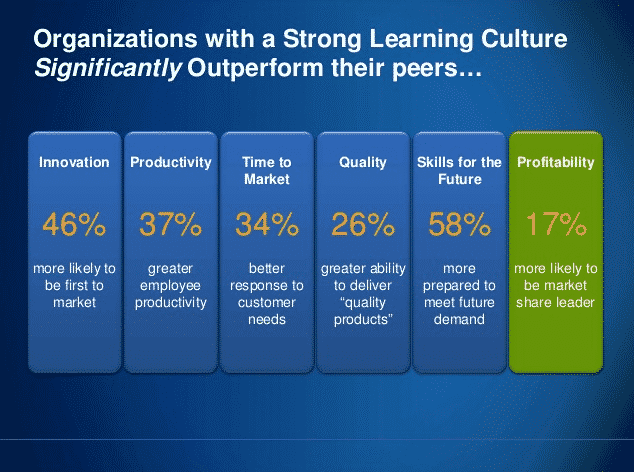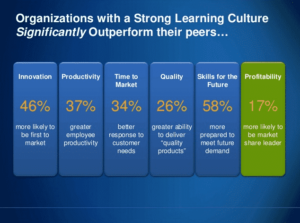How to Create a Culture of Continuous Learning

In his recent presentation, “21st Century Management: The New Ways Companies Hire, Engage, and Lead”, Josh Bersin outlines his thoughts on all things related to “people management” and how world-class companies will continue to lead the pack in 2014.
Among his predictions on how companies will influence engagement, manage millennials, and retain the best talent are thoughts on creating what he calls a continuous learning organization.
Based on their research, Bersin asserts that organizations with a strong learning culture significantly outperform their peers in several measures like innovation, productivity, and most importantly— profitability.

It is evident that an emphasis on learning and development can translate directly to bottom-line results for your company, but just how does one go about creating a “strong learning culture”? For many organizations the methods of delivery matter as much as the design of the content. In fact, as I noted in my summary from a recent learning and development conference, the conversation is the content in the most advanced organizations.
The findings from Bersin’s research align well with data that emerged from a study conducted by the Human Capital Institute in 2012 that outlined which methods of executive development and corporate learning were most effective. HCI’s research divided common learning methods into 2 camps: traditional and non-traditional.
The report stated that:
“Executive Development has evolved from singular, individual, and classroom-based methods to more cooperative and peer-based activities that leverage discussion, group problem-solving, and knowledge transfer among executive leaders. This new, non-traditional Executive Development process leverages experiential learning techniques, interactivity, and more frequent participation by leaders. The result is a more integrated, structured program to provide executives the opportunity to better and more thoroughly develop the skills they need to lead effectively.”
 Non-traditional methods of learning can help your organization create meaningful conversations, which will increase the application, reinforcement, and retention of the learning that happens through traditional methods.
Non-traditional methods of learning can help your organization create meaningful conversations, which will increase the application, reinforcement, and retention of the learning that happens through traditional methods.
HCI’s research concluded that the organizations that achieved the greatest return on their investment in learning actually combined many types of methods to create a more holistic development structure.
How is your organization combining development methods to create a strong learning culture?
Category: Leadership Talent Management
Tags:


Agree w/ point = “the conversation is the content in the most advanced organizations.”
In knowledge based economies where SME’s are high value recruitment targets engagement is the commerce of choice.